-
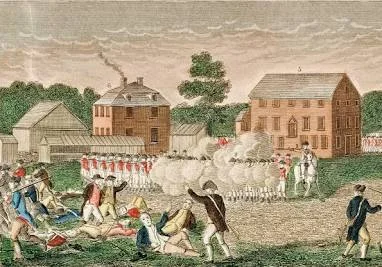 The Battles of Lexington and Concord took place on April 19, 1775, marking the beginning of the American Revolution. This series of engagements saw colonial militia confronting British forces as they marched from Boston to seize colonial military supplies in Concord, Massachusetts, with the initial skirmishes occurring in Lexington.
The Battles of Lexington and Concord took place on April 19, 1775, marking the beginning of the American Revolution. This series of engagements saw colonial militia confronting British forces as they marched from Boston to seize colonial military supplies in Concord, Massachusetts, with the initial skirmishes occurring in Lexington. -
The Winter at Valley Forge refers to the harsh encampment of the Continental Army under George Washington during the winter of 1777-1778, a period of extreme hardship and suffering.
-
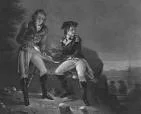 Benedict Arnold became a traitor on September 21, 1780, when he met with British Major John André to finalize the plot to surrender the crucial American stronghold of West Point to the British in exchange for money and a position in the British army. While Arnold had begun secretly corresponding with the British earlier, this meeting marked the point of no return for his betrayal of the American cause.
Benedict Arnold became a traitor on September 21, 1780, when he met with British Major John André to finalize the plot to surrender the crucial American stronghold of West Point to the British in exchange for money and a position in the British army. While Arnold had begun secretly corresponding with the British earlier, this meeting marked the point of no return for his betrayal of the American cause. -
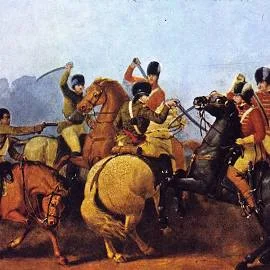 Battle of Cowpens - At the Cowpens, a frontier pastureland, on January 17, 1781, Daniel Morgan led his army of tough Continentals and backwoods militia to a brilliant victory over Banastre Tarleton's battle-hardened force of British regulars. Located in present-day South Carolina north of Spartanburg.
Battle of Cowpens - At the Cowpens, a frontier pastureland, on January 17, 1781, Daniel Morgan led his army of tough Continentals and backwoods militia to a brilliant victory over Banastre Tarleton's battle-hardened force of British regulars. Located in present-day South Carolina north of Spartanburg. -
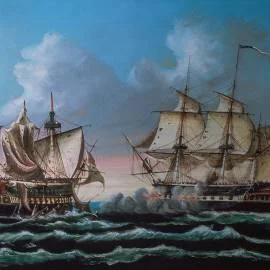 On the afternoon of August 19, 1812 Hull and his crew sighted the British frigate HMS Guerriere, under the command of Captain James Richard Dacres.
On the afternoon of August 19, 1812 Hull and his crew sighted the British frigate HMS Guerriere, under the command of Captain James Richard Dacres. -
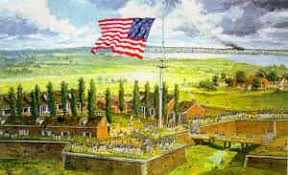 The Battle of Baltimore took place between British and American forces on September 12–14, 1814, during the War of 1812. Defending American forces repulsed sea and land invasions off the busy port city of Baltimore, Maryland, by British forces.
The Battle of Baltimore took place between British and American forces on September 12–14, 1814, during the War of 1812. Defending American forces repulsed sea and land invasions off the busy port city of Baltimore, Maryland, by British forces. -
 History and the Census: The 1815 Battle of New Orleans. On January 8, 1815, future President of the United States General Andrew Jackson led American troops to victory during the Battle of New Orleans.
History and the Census: The 1815 Battle of New Orleans. On January 8, 1815, future President of the United States General Andrew Jackson led American troops to victory during the Battle of New Orleans. -
 The Battle of the Alamo (February 23 – March 6, 1836) was a pivotal event and military engagement in the Texas Revolution. Following a 13-day siege, Mexican troops under President General Antonio López de Santa Anna reclaimed the Alamo Mission near San Antonio de Béxar (modern-day San Antonio, Texas, United States).
The Battle of the Alamo (February 23 – March 6, 1836) was a pivotal event and military engagement in the Texas Revolution. Following a 13-day siege, Mexican troops under President General Antonio López de Santa Anna reclaimed the Alamo Mission near San Antonio de Béxar (modern-day San Antonio, Texas, United States). -
 Mexico ceded the territories of California, New Mexico, Arizona, and parts of other current U.S. states to the United States with the signing of the Treaty of Guadalupe Hidalgo on February 2, 1848, which ended the Mexican-American War. This treaty resulted in Mexico losing approximately half of its territory.
Mexico ceded the territories of California, New Mexico, Arizona, and parts of other current U.S. states to the United States with the signing of the Treaty of Guadalupe Hidalgo on February 2, 1848, which ended the Mexican-American War. This treaty resulted in Mexico losing approximately half of its territory. -
Abraham Lincoln was elected President of the United States in November 1860.
-
South Carolina seceded from the United States on December 20, 1860, marking the beginning of the American Civil War.
-
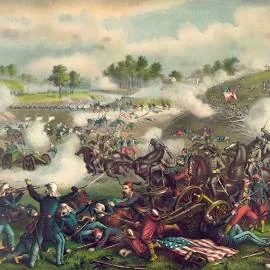 The First Battle of Bull's Run (also known as First Manassas) was the first major land battle of the Civil War. On July 21, 1861, the Union army, commanded by General Irvin McDowell engaged the forces of Confederate general, P.G.T. Beauregard, 25 miles southwest of the Capital.
The First Battle of Bull's Run (also known as First Manassas) was the first major land battle of the Civil War. On July 21, 1861, the Union army, commanded by General Irvin McDowell engaged the forces of Confederate general, P.G.T. Beauregard, 25 miles southwest of the Capital. -
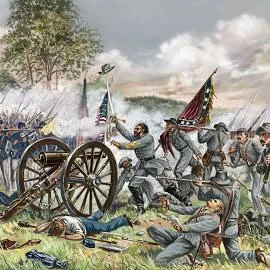 The Battle of Gettysburg was fought July 1–3, 1863, in and around the town of Gettysburg, Pennsylvania, by Union and Confederate forces during the American Civil War. The battle involved the largest number of casualties of the entire war and is often described as the war's turning point.
The Battle of Gettysburg was fought July 1–3, 1863, in and around the town of Gettysburg, Pennsylvania, by Union and Confederate forces during the American Civil War. The battle involved the largest number of casualties of the entire war and is often described as the war's turning point. -
This occurred on April 9, 1865 when Confederate General Robert E. Lee surrendered to Union General Ulysses S. Grant, effectively ending the American Civil War.
-
 The sinking of the USS Maine occurred on February 15, 1898. The U.S. battleship was in Havana, Cuba, when a massive explosion sank the ship, killing the majority of its crew. The incident became a major catalyst for the Spanish-American War, which began in April 1898.
The sinking of the USS Maine occurred on February 15, 1898. The U.S. battleship was in Havana, Cuba, when a massive explosion sank the ship, killing the majority of its crew. The incident became a major catalyst for the Spanish-American War, which began in April 1898. -
 The primary engagement in the Philippines during the Spanish-American War was the Battle of Manila Bay, which occurred on May 1, 1898. During this battle, U.S. forces under Commodore George Dewey destroyed the Spanish fleet in Manila Bay, marking the first major engagement of the war and the end of Spanish colonial rule in the Philippines.
The primary engagement in the Philippines during the Spanish-American War was the Battle of Manila Bay, which occurred on May 1, 1898. During this battle, U.S. forces under Commodore George Dewey destroyed the Spanish fleet in Manila Bay, marking the first major engagement of the war and the end of Spanish colonial rule in the Philippines. -
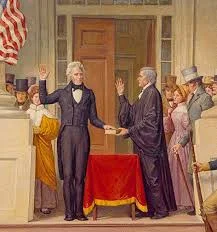 President Andrew Jackson had become a national hero when he defeated the British at New Orleans in the War of 1812.
President Andrew Jackson had become a national hero when he defeated the British at New Orleans in the War of 1812. -
 "The Star-Spangled Banner" was officially adopted as the national anthem of the United States on March 3, 1931, when President Herbert Hoover signed a bill into law that designated the song as the official national anthem. The song was written by Francis Scott Key in 1814 during the War of 1812 and had been unofficially used as a national anthem before its official adoption.
"The Star-Spangled Banner" was officially adopted as the national anthem of the United States on March 3, 1931, when President Herbert Hoover signed a bill into law that designated the song as the official national anthem. The song was written by Francis Scott Key in 1814 during the War of 1812 and had been unofficially used as a national anthem before its official adoption.